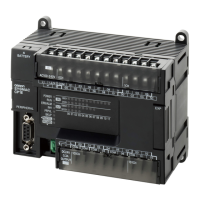5 Installation and Wiring
5-24
CP1E CPU Unit Hardware User’s Manual(W479)
z Countermeasure Examples
• When switching an inductive load, connect a surge protector, diodes, etc., in parallel with the load
or contact as shown below.
• When switching a load with a high inrush current such as an incandescent lamp, suppress the
inrush current as shown below.
Circuit
Current
Characteristic Required element
AC DC
CR method
OK OK
If the load is a relay or solenoid, there is
a time lag between the moment the cir-
cuit is opened and the moment the load
is reset.
If the supply voltage is 24 or 48 V, insert
the arc killer in parallel with the load. If
the supply voltage is 100 to 200V, insert
the arc killer between the contacts.
The capacitance of the capacitor must be
1 to 0.5 µF per contact current of 1 A and
resistance of the resistor must be 0.5 to
1 Ω per contact voltage of 1 V.
These values, however, vary with the load
and the characteristics of the relay.
Decide these values from experiments,
and take into consideration that the
capacitance suppresses spark discharge
when the contacts are separated and the
resistance limits the current that flows into
the load when the circuit is closed again.
The dielectric strength of the capacitor
must be 200 to 300 V. If the circuit is an
AC circuit, use a capacitor with no polarity.
Diode method
--- OK
The diode connected in parallel with the
load changes energy accumulated by
the coil into a current, which then flows
into the coil so that the current will be
converted into Joule heat by the resis-
tance of the inductive load.
This time lag, between the moment the
circuit is opened and the moment the
load is reset, caused by this method is
longer than that caused by the CR
method.
The reversed dielectric strength value of
the diode must be at least 10 times as
large as the circuit voltage value. The for-
ward current of the diode must be the
same as or larger than the load current.
The reversed dielectric strength value of
the diode may be two to three times larger
than the supply voltage if the surge pro-
tector is applied to electronic circuits with
low circuit voltages.
Varistor method
OK OK
The varistor method prevents the impo-
sition of high voltage between the con-
tacts by using the constant voltage
characteristic of the varistor. There is
time lag between the moment the circuit
is opened and the moment the load is
reset.
If the supply voltage is 24 or 48 V, insert
the varistor in parallel with the load. If
the supply voltage is 100 to 200 V,
insert the varistor between the contacts.
−
Power C
R
Inductive load
Power
Inductive load
Power
Inductive load
OUT
R
COM
L
+
OUT
R
COM
L
+
[Method 1]
Providing a limiting resistor
Providing a dark current of approx. one-third of
the rated value through an incandescent lamp
[Method 2]

